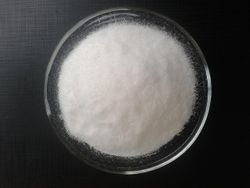Ammonium dihydrogen phosphate
From Sciencemadness Wiki
Revision as of 16:49, 12 March 2016 by Mabus (Talk | contribs) (Created page with "{{Chembox | Name = Ammonium dihydrogen phosphate | Reference = | IUPACName = Ammonium dihydrogen phosphate | PIN = | SystematicName = | OtherNames = Monoammonium phosphate<br>...")
 Agricultural MAP sample
| |
| Names | |
|---|---|
| IUPAC name
Ammonium dihydrogen phosphate
| |
| Other names
Monoammonium phosphate
MAP | |
| Identifiers | |
| Jmol-3D images | Image |
| |
| Properties | |
| H6NO4P NH4H2PO4 | |
| Molar mass | 115.02 g/mol |
| Appearance | Crystalline white solid |
| Odor | Odorless |
| Density | 1.80 g/cm3 |
| Melting point | 190 °C (374 °F; 463 K) |
| Boiling point | Decomposes |
| 40.4 g/100 mL | |
| Solubility | Soluble in ethanol Insoluble in acetone |
| Thermochemistry | |
| Std enthalpy of
formation (ΔfH |
−1445.07 kJ/mol |
| Hazards | |
| Safety data sheet | Fisher Scientific |
| Lethal dose or concentration (LD, LC): | |
| LD50 (Median dose)
|
5750 mg/kg (rat, oral) |
| Related compounds | |
| Related compounds
|
Phosphoric acid |
| Except where otherwise noted, data are given for materials in their standard state (at 25 °C [77 °F], 100 kPa). | |
| Infobox references | |
Ammonium dihydrogen phosphate (ADP), more commonly known as monoammonium phosphate (MAP), is an inorganic chemical compound with the formula NH4H2PO4, mainly used as a fertilizer.
Contents
Properties
Chemical
Physical
MAP is a crystalline white solid, soluble in water. It has a density of 1.80 g/cm3.
Availability
Ammonium dihydrogen phosphate is sold as fertilizer, and it's fairly pure.
It is also available as the main component of dry powder fire extinguishers.
Preparation
Ammonium dihydrogen phosphate can be made by reacting ammonium bicarbonate or ammonium carbonate with phosphoric acid, with the following molar ratio:
- NH4HCO3 + H3PO4 → NH4H2PO4 + H2O + CO2
- (NH4)2CO3 + 2 H3PO4 → 2 NH4H2PO4 + 2 H2O + 2 CO2
Projects
- Make piezoelectric crystals
Handling
Safety
MAP is safe to handle and has little toxicity.
Storage
MAP should be stored in closed bottles.
Disposal
MAP can be dumped in the ground or poured down the drain.
References
Relevant Sciencemadness threads
Categories:
- Chemical pages without CAS Registry Number
- Articles without EBI source
- Chemical pages without ChemSpiderID
- Chemical pages without DrugBank identifier
- Articles without KEGG source
- Articles without InChI source
- Articles without UNII source
- Articles containing unverified chemical infoboxes
- Chemical compounds
- Inorganic compounds
- Ammonium compounds
- Phosphates
- Readily available chemicals